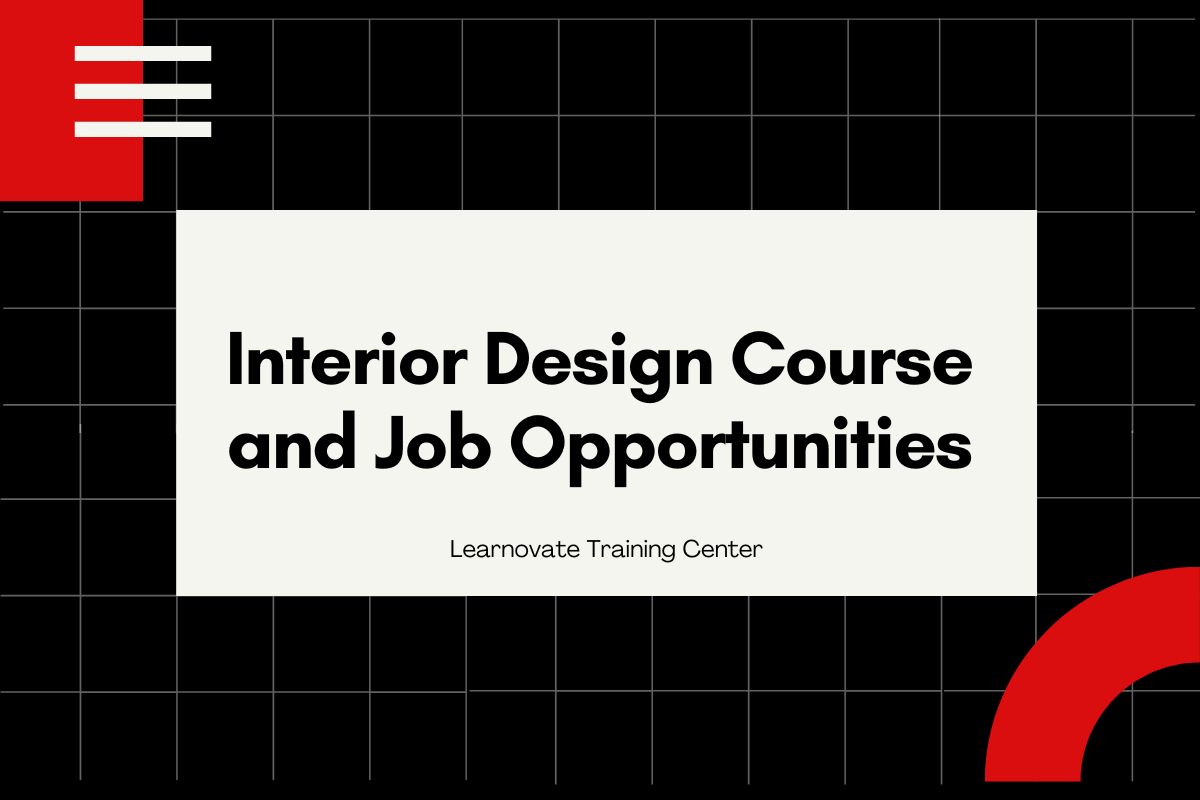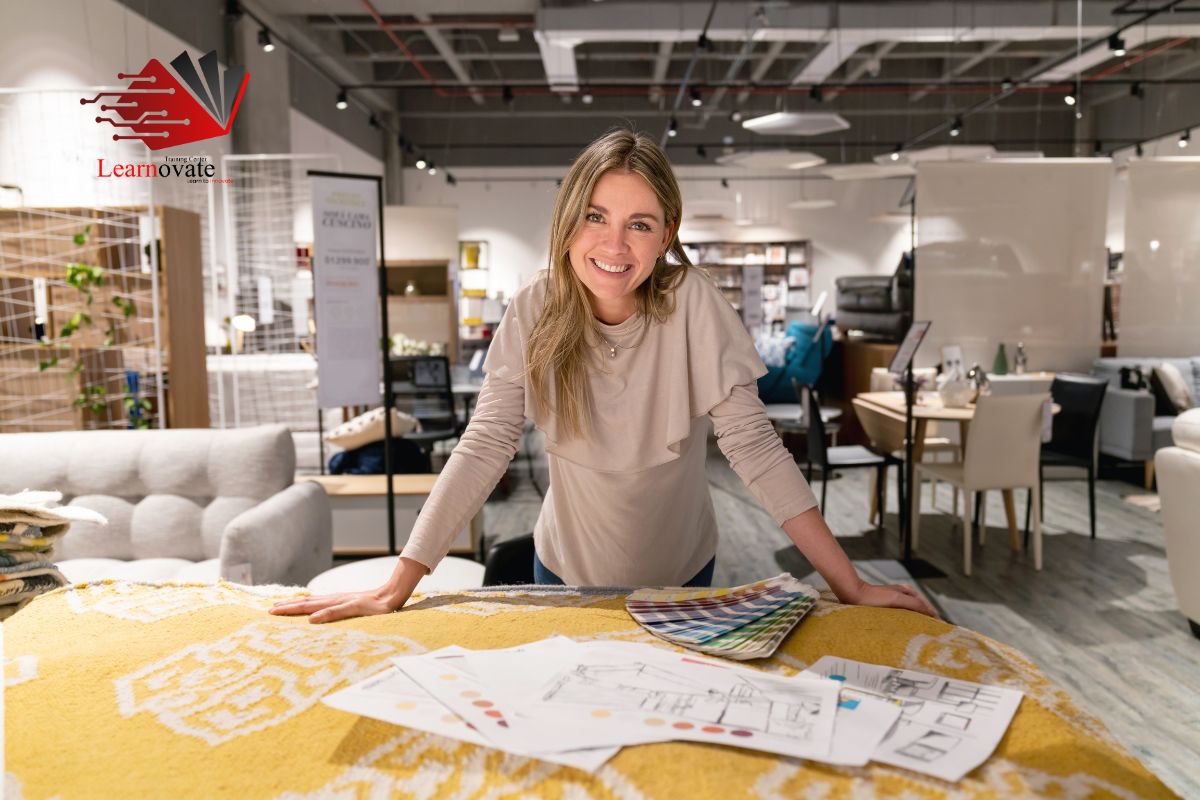Have you ever walked into a room that felt welcoming, stylish, and functional all at once? That’s the magic of interior design! The world of interior design is not just about making spaces look beautiful; it’s about creating environments that influence how we feel and function in them. And if you are passionate about transforming spaces, a interior design course might be the perfect step toward your dream career.
With the growing demand for skilled professionals in the field, the role of an interior designer is more important than ever. As businesses, homeowners, and organizations realize the importance of good design in shaping environments, interior design professionals are sought to create functional, aesthetically pleasing, and innovative spaces. The best part? There are a wide range of career opportunities waiting for you, whether you’re looking to work in a design firm, a corporate setting, or even freelance!
Imagine turning your creative ideas into a career that allows you to work on exciting projects, collaborate with clients, and express your artistic vision. Whether you’re passionate about residential design, commercial spaces, or sustainable interiors, enrolling in an interior design course can give you the skills and knowledge to make this a reality. But what does the course entail, and what kind of job opportunities can you expect after completing it?
In this blog, we’ll take a deep dive into the world of interior design, exploring the benefits of an interior design course, what you’ll learn, and the amazing job opportunities that await. Ready to turn your passion for design into a rewarding career? Let’s get started!
What is Interior Design?
Interior design is the art and science of enhancing the interior of a building to achieve a more aesthetically pleasing and functional environment. It involves understanding the space, the people who use it, and designing accordingly to meet their needs. An interior designer does more than just choose colors and furniture; they are experts in creating environments that are safe, functional, and inspiring.
There are various types of interior design specialties, including residential design, commercial design, and hospitality design. Each requires a different approach, but all demand creativity, technical expertise, and a strong understanding of how people interact with their surroundings.
To succeed in interior design, one must have an eye for detail, creativity, and a solid foundation in design principles, such as balance, harmony, scale, and proportion. These qualities can be honed and developed through an interior design course.
Why Choose an Interior Design Course?
Taking an interior design course is an excellent way to lay the foundation for a successful career. Here are several reasons why pursuing formal education in interior design can be a game-changer:
- Skill Development: An interior design course will teach you the essential skills required to excel in the industry. From mastering design software to learning about color theory, space planning, and lighting, the course covers all aspects of the profession.
- Industry Tools and Software: Courses often include training in industry-standard software like AutoCAD, SketchUp, and Adobe Creative Suite, which are essential for creating designs and floor plans. These tools help you communicate your ideas effectively and bring your creative vision to life.
- Practical Experience: Many interior design programs include hands-on projects, internships, or opportunities to work on real-world projects. This practical experience is invaluable when entering the job market.
- Networking Opportunities: Enrolling in an interior design course opens doors to networking opportunities with industry professionals, professors, and fellow students. Building these connections early can help you land your first job in the field.
Course Content and Curriculum
The curriculum of an interior design course is carefully designed to cover both the creative and technical aspects of the profession. Here’s an overview of what you can expect to learn during the course:
- Introduction to Interior Design: The basics of the profession, including its history, core principles, and key areas of specialization.
- Space Planning: Learning how to design spaces that are functional and aesthetically pleasing while considering the client’s needs and the space’s limitations.
- Color Theory: Understanding how colors impact mood, space perception, and how to effectively use color in design.
- Furniture Design and Layout: Gaining knowledge of furniture styles, materials, and how to arrange furniture in a way that maximizes space and functionality.
- Lighting Design: Learning the importance of lighting in interior spaces and how to use it to create ambiance, highlight features, and improve functionality.
- Materials and Textiles: Exploring the various materials used in interior design, including textiles, finishes, and flooring options.
- Design Software: Training in AutoCAD, SketchUp, and other design tools to help you create accurate and professional designs.
Advanced modules might include sustainable design, lighting design, 3D rendering, and project management. These topics are designed to give you a deeper understanding of the industry and enhance your employability.
Job Opportunities in Interior Design
Once you’ve completed an interior design course, you’ll be equipped with the skills necessary to pursue a variety of job opportunities in the field. Here are some common career paths:
- Interior Designer: As a professional interior designer, you’ll be responsible for creating design concepts, developing plans, selecting materials, and overseeing the execution of designs.
- Design Consultant: Some interior designers work as consultants, advising clients on design ideas and solutions. This role often involves working on a freelance or contract basis.
- Space Planner: Space planners focus on designing the layout of a space to optimize its functionality, ensuring that the space flows efficiently and meets the needs of its users.
- Lighting Designer: Specializing in lighting, lighting designers create lighting plans that enhance the aesthetic appeal and functionality of a space.
- Project Manager: Interior design project managers oversee the entire design process, from concept to completion, ensuring that projects are completed on time, within budget, and according to client specifications.
Employers in this industry include design firms, architectural companies, real estate developers, retailers, and corporations. Alternatively, many interior designers choose to work as freelancers or start their own design businesses.
Job Market and Salary Prospects
The demand for qualified interior designers is on the rise. As of recent reports, the interior design profession has seen steady job growth, particularly in the commercial and residential sectors. On average, interior designers can expect to earn anywhere from $50,000 to $75,000 annually, with top professionals making over $100,000 depending on their experience and specialization.
Freelance interior designers or those who run their businesses can often set their rates based on the complexity and scope of each project.
Skills and Qualities Employers Look For
While a degree or certification in interior design is important, employers also look for specific skills and qualities in candidates. Here are some key traits you’ll need to succeed:
- Technical Proficiency: Expertise in design software, drafting tools, and 3D modeling is a must for modern interior designers. Employers value candidates who are proficient in tools like AutoCAD, SketchUp, and Adobe Illustrator.
- Creativity: As an interior designer, you’ll need to think outside the box and come up with innovative design solutions. Your creativity will help you create unique, functional, and aesthetically pleasing spaces.
- Attention to Detail: Interior designers must pay close attention to every element of a design, from the layout to the color palette and the finishing touches. Small details can make a big difference.
- Communication Skills: Being able to communicate your ideas clearly to clients, contractors, and other stakeholders is crucial. Strong communication skills are essential for explaining design concepts and managing client expectations.
- Problem-Solving Abilities: Designers often face challenges during the design process, whether it’s dealing with space constraints or balancing the budget. The ability to find creative solutions to problems is essential.
Industry Trends and Demand for Interior Designers
The interior design industry is constantly evolving. Some current trends include:
- Sustainable and Eco-Friendly Design: With growing concern over the environment, many clients are looking for eco-friendly materials and energy-efficient designs. Sustainable interior design is becoming a major trend, and many design firms are focusing on green building practices.
- Smart Homes: Technology is increasingly integrated into interior design, from smart lighting to automated climate control systems. Designers need to stay up-to-date with the latest tech trends to meet clients’ expectations.
- Minimalism and Open Spaces: The trend toward minimalism continues, with an emphasis on open, uncluttered spaces that prioritize functionality and comfort.
These trends create exciting opportunities for interior designers to specialize in areas like sustainable design, smart home integration, and minimalist aesthetics, ensuring that job prospects remain strong for those entering the field.
How to Kickstart Your Career After the Course
After completing your interior design course, here are a few steps to help you kickstart your career:
- Build a Portfolio: Start working on personal projects or take on small freelance gigs to build a portfolio that showcases your skills and creativity.
- Internships: Consider applying for internships with design firms or architecture companies to gain real-world experience and expand your professional network.
- Networking: Attend industry events, conferences, and workshops to meet professionals in the field. Join professional organizations like the American Society of Interior Designers (ASID) to gain recognition and credibility.
- Freelance: If you prefer flexibility, then you work as a freelance at home or anywhere, where you feel free to work.
Tips for Success in the Interior Design Industry
As you embark on your journey into the world of interior design, there are a few things to keep in mind to ensure that you thrive in this dynamic and competitive field. Here are some practical tips for success:
- Stay Updated with Trends: The design industry is constantly evolving, with new styles, materials, and technologies emerging regularly. To stay competitive, make it a habit to follow design blogs, attend webinars, and read industry magazines. Familiarizing yourself with the latest trends will not only inspire your creativity but also make you more marketable to clients and employers.
- Master Your Time Management: Interior design projects often involve tight deadlines, complex requirements, and multiple stakeholders. Developing strong time management skills is essential to ensure that you meet deadlines and deliver high-quality work on time.
- Collaborate with Other Professionals: Interior designers often work with architects, contractors, and furniture designers. Building strong relationships with these professionals can help you access more opportunities and complete projects successfully.
- Seek Feedback: Don’t be afraid to ask for feedback from clients, colleagues, or mentors. Constructive criticism can help you improve your designs and grow as a professional.
- Build a Personal Brand: In today’s digital world, a strong online presence can significantly boost your career prospects. Develop a portfolio website to showcase your work, share your process, and let potential clients and employers get to know you. You can also leverage social media platforms like Instagram and Pinterest to share your designs and build a following.
- Stay Flexible and Adaptable: Clients may change their mind about a design mid-project, or new constraints may arise. The ability to adapt to these changes while maintaining a positive attitude is a key trait of successful interior designers.
Further Education and Specialization
As you gain experience in the field, you may decide to specialize in a particular aspect of interior design or pursue advanced studies to expand your knowledge. Some areas to consider include:
- Sustainable Interior Design: If you’re passionate about eco-friendly practices, you might consider specializing in sustainable design, which focuses on using environmentally friendly materials and energy-efficient systems in design projects.
- Commercial Interior Design: Commercial spaces, such as offices, retail stores, and restaurants, require a different approach than residential interiors. Specializing in this area could open doors to exciting, high-budget projects.
- 3D Modeling and Visualization: As technology advances, 3D rendering and virtual reality are becoming more prominent in interior design. Mastering these tools can set you apart in a competitive job market.
- Project Management: For those who enjoy overseeing large projects and managing teams, project management certifications or courses could be an excellent way to expand your role within the interior design industry.
- Lighting Design: Specializing in lighting design can give you the opportunity to work on high-profile projects, where lighting plays a crucial role in creating ambiance and improving functionality.
Further education and specialization can not only make you more competitive but also allow you to command higher rates and work on more prestigious projects.
The Future of Interior Design: A Growing Field
The future of interior design is bright, with increasing demand across both residential and commercial sectors. As more people prioritize well-designed living spaces and businesses focus on creating engaging environments for employees and customers, the need for skilled interior designers will continue to grow.
Some key trends that will shape the future of interior design include:
- Technology Integration: With smart homes and IoT (Internet of Things) devices becoming more common, interior designers will need to integrate these technologies into their designs, ensuring that spaces are both functional and high-tech.
- Health and Wellness: As the importance of mental and physical well-being continues to grow, interior designers will play a key role in designing spaces that promote relaxation, comfort, and mindfulness. This includes focusing on elements like natural light, air quality, biophilic design, and ergonomic furniture.
- Remote Workspaces: As remote work becomes more common, there will be an increased demand for home offices and workspaces that are designed to be both functional and inspiring. Interior designers who can create productive and aesthetically pleasing work-from-home setups will be in high demand.
- Globalization and Cultural Awareness: As interior design becomes more globalized, designers will need to understand different cultures, preferences, and needs. Whether it’s adapting designs to fit local tastes or working on international projects, cultural sensitivity will be an important skill to possess.
Conclusion
Choosing to pursue an interior design course is a powerful step toward a fulfilling and rewarding career. With creativity, technical expertise, and the right educational background, you can transform your passion for design into a career that allows you to influence how people experience the spaces around them.
Whether you’re interested in working for a design firm, starting your own business, or freelancing, there are countless opportunities available for interior designers. The key is to equip yourself with the skills, knowledge, and industry insights needed to succeed.
Remember, interior design is not just about making spaces look beautiful—it’s about making spaces work better for the people who inhabit them. So, if you’re ready to take your passion to the next level and embark on a journey of creativity, innovation, and personal fulfillment, an interior design course is the first step toward unlocking your future in this exciting industry















